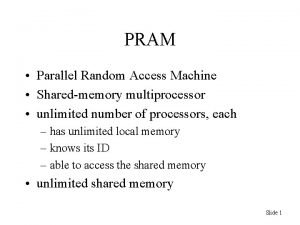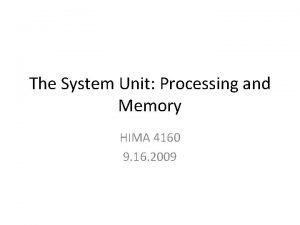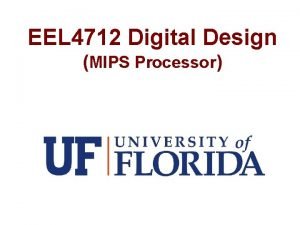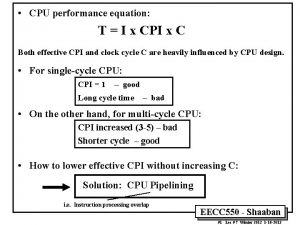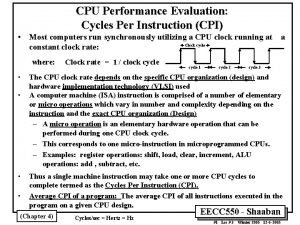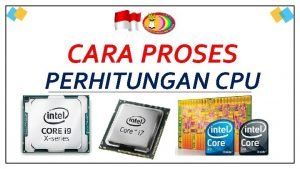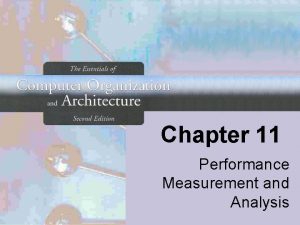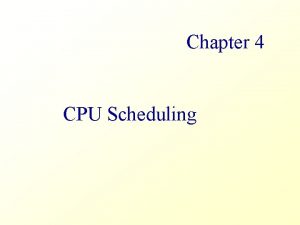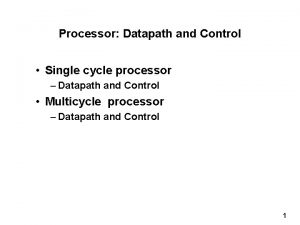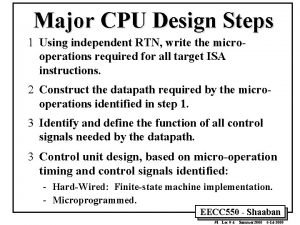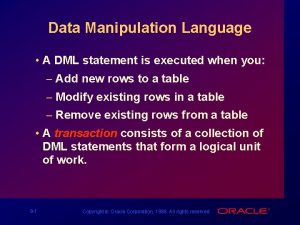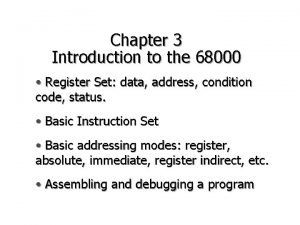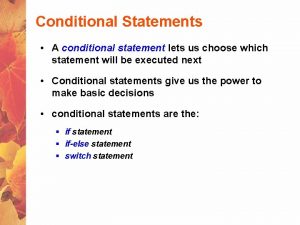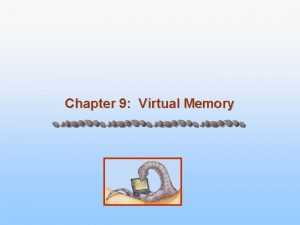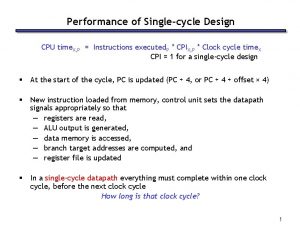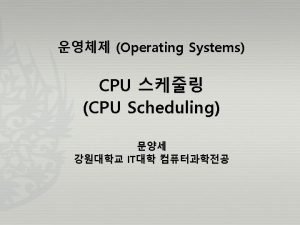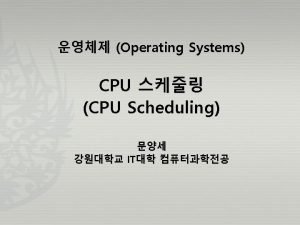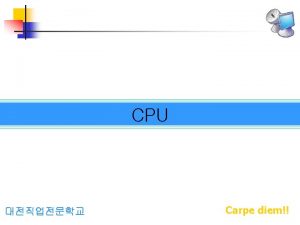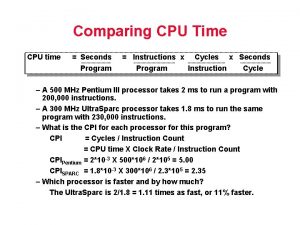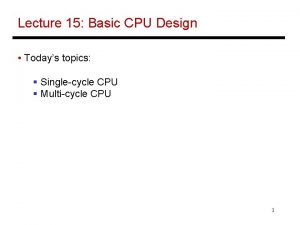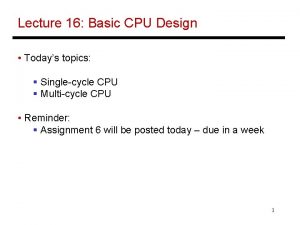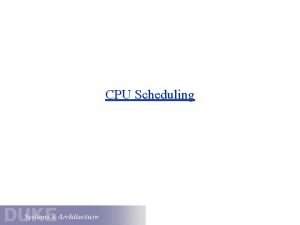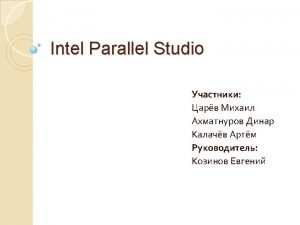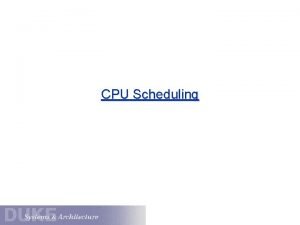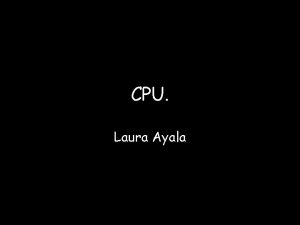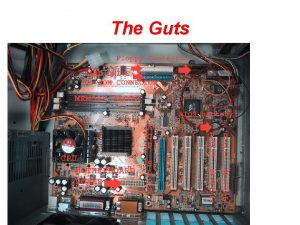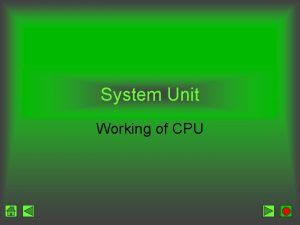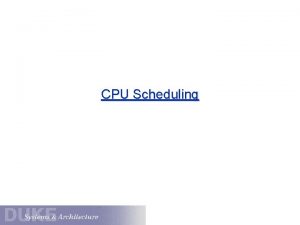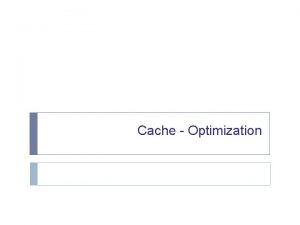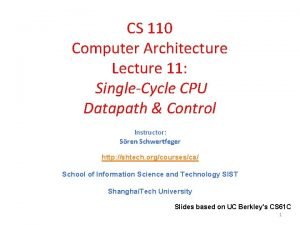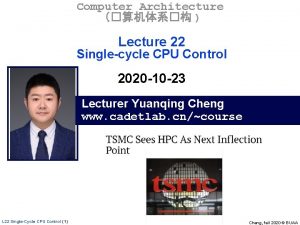Performance of Singlecycle Design CPU time Instructions executed











![Memory (MEM) § …the MEM portion… Reg. Write Read Instruction address [31 -0] Mem. Memory (MEM) § …the MEM portion… Reg. Write Read Instruction address [31 -0] Mem.](https://slidetodoc.com/presentation_image_h2/639c5e236d54db4b5c93b449226a4bfa/image-12.jpg)








- Slides: 20

Performance of Single-cycle Design CPU time = Instructions executed CPI Clock cycle time CPI = 1 for a single-cycle design § At the start of the cycle, PC is updated (PC + 4, or PC + 4 + offset × 4) § New instruction loaded from memory, control unit sets the datapath signals appropriately so that — registers are read, — ALU output is generated, — data memory is accessed, — branch target addresses are computed, and — register file is updated § In a single-cycle datapath everything must complete within one clock cycle, before the next clock cycle How long is that clock cycle? 1

Components of the data-path § Each component of the datapath has an associated delay (latency) reading the instruction memory 2 ns reading the register file 1 ns 8 ns ALU computation 2 ns accessing data memory 2 ns writing to the register file 1 ns § The cycle time has to be large enough to accommodate the slowest instruction Read Instruction address [31 -0] I [25 - 21] Read register 1 I [20 - 16] Instruction memory 2 ns 0 M u I [15 - 11] x 1 0 ns I [15 - 0] Read data 1 Zero Read register 2 Read data 2 Write register Write data ALU 0 M u x Registers 1 0 ns 1 ns Result 2 ns Read address Read data 1 Data memory 0 Write address Write data M u x 0 ns 2 ns Sign extend 0 ns 2

How bad is this? § With these same component delays, a sw instruction would need 7 ns, and beq would need just 5 ns § Let’s consider the gcc instruction mix: Instruction Frequency Arithmetic Loads Stores Branches 48% 22% 11% 19% § With a single-cycle datapath, each instruction would require 8 ns § But if we could execute instructions as fast as possible, the average time per instruction for gcc would be: (48% x 6 ns) + (22% x 8 ns) + (11% x 7 ns) + (19% x 5 ns) = 6. 36 ns § The single-cycle datapath is about 1. 26 times slower! 3

Improving performance § Two ideas for improving performance: 1. Spilt each instruction into multiple steps, each taking 1 cycle § steps: IF (instruction fetch), ID (instruction decode), EX (execute ALU operation), MEM (memory access), WB (register write-back) § slow instructions take more cycles than fast instructions § known as a multi-cycle implementation 2. Crucial observation: each instruction uses only a portion of the datapath in each step § can overlap instructions; each uses one portion of the datapath § known as a pipelined implementation § Examples of pipelining: any assembly process (cars, etc. ), multiple loads of laundry (washer + dryer), … 4

Pipelining: Example § Assembling a sandwich: Order, Toast (optional), Add extras, Pay — ORD (8 seconds) — TOS (0 or 10 seconds) — ADD (0 to 10 seconds) — PAY (5 seconds) A single sandwich takes between 13 and 33 seconds § We can assemble sandwiches every 10 seconds with pipelining: ORD TOS ADD PAY 0 10 20 30 40 50 60 5

Pipelining lessons § Pipelining can increase throughput (#sandwiches per hour), but… 1. Every sandwich must use all stages — prevents clashes in the pipeline 2. Every stage must take the same amount of time — limited by the slowest stage (in this example, 10 seconds) § These two factors decrease the latency (time per sandwich)! § For an optimal k-stage pipeline: 1. every stage does useful work 2. stage lengths are balanced § Under these conditions, we nearly achieve the optimal speedup: k — “nearly” because there is still the fill and drain time 6

Pipelining not just Multiprocessing § Pipelining does involve parallel processing, but in a specific way § Both multiprocessing and pipelining relate to the processing of multiple “things” using multiple “functional units” — In multiprocessing, each thing is processed entirely by a single functional unit • e. g. multiple lanes at the supermarket — In pipelining, each thing is broken into a sequence of pieces, where each piece is handled by a different (specialized) functional unit • e. g. checker vs. bagger § Pipelining and multiprocessing are not mutually exclusive — Modern processors do both, with multiple pipelines (e. g. superscalar) § Pipelining is a general-purpose efficiency technique; used elsewhere in CS: — Networking, I/O devices, server software architecture 7

Pipelining MIPS § Executing a MIPS instruction can take up to five stages Step Name Instruction Fetch IF Description Read an instruction from memory Instruction Decode ID Read source registers and generate control signals Execute EX Compute an R-type result or a branch outcome Memory MEM Read or write the data memory Writeback WB Store a result in the destination register § Not all instructions need all five stages and stages have different lengths Instruction Steps required beq IF ID EX R-type IF ID EX sw IF ID EX MEM lw IF ID EX MEM WB WB § Clock cycle time determined by length of slowest stage (2 ns here) 8

Instruction Fetch (IF) § While IF is executing, the rest of the datapath is sitting idle… Reg. Write Read Instruction address [31 -0] Mem. Write I [25 - 21] Read register 1 I [20 - 16] Instruction memory 0 M u I [15 - 11] x 1 Read register 2 Write register Write data Read data 1 Zero Read data 2 Registers 0 M u x 1 ALUSrc Reg. Dst I [15 - 0] ALU Result ALUOp Read address Read data 1 Data memory 0 Write address Write data Mem. To. Reg M u x Mem. Read Sign extend 9

Instruction Decode (ID) § Then while ID is executing, the IF-related portion becomes idle… Reg. Write Read Instruction address [31 -0] Mem. Write I [25 - 21] Read register 1 I [20 - 16] Instruction memory 0 M u I [15 - 11] x 1 Read register 2 Write register Write data Read data 1 Zero Read data 2 Registers 0 M u x 1 ALUSrc Reg. Dst I [15 - 0] ALU Result ALUOp Read address Read data 1 Data memory 0 Write address Write data Mem. To. Reg M u x Mem. Read Sign extend 10

Execute (EX) §. . and so on for the EX portion… Reg. Write Read Instruction address [31 -0] Mem. Write I [25 - 21] Read register 1 I [20 - 16] Instruction memory 0 M u I [15 - 11] x 1 Read register 2 Write register Write data Read data 1 Zero Read data 2 Registers 0 M u x 1 ALUSrc Reg. Dst I [15 - 0] ALU Result ALUOp Read address Read data 1 Data memory 0 Write address Write data Mem. To. Reg M u x Mem. Read Sign extend 11
![Memory MEM the MEM portion Reg Write Read Instruction address 31 0 Mem Memory (MEM) § …the MEM portion… Reg. Write Read Instruction address [31 -0] Mem.](https://slidetodoc.com/presentation_image_h2/639c5e236d54db4b5c93b449226a4bfa/image-12.jpg)
Memory (MEM) § …the MEM portion… Reg. Write Read Instruction address [31 -0] Mem. Write I [25 - 21] Read register 1 I [20 - 16] Instruction memory 0 M u I [15 - 11] x 1 Read register 2 Write register Write data Read data 1 Zero Read data 2 Registers 0 M u x 1 ALUSrc Reg. Dst I [15 - 0] ALU Result ALUOp Read address Read data 1 Data memory 0 Write address Write data Mem. To. Reg M u x Mem. Read Sign extend 12

Writeback (WB) § …and the WB portion § What about the “clash” with the IF stage over the register file? § Answer: Register file is read at the end of the clock cycle, but written at the start of the clock cycle. Hence, there is no clash Reg. Write Read Instruction address [31 -0] Mem. Write I [25 - 21] Read register 1 I [20 - 16] Instruction memory 0 M u I [15 - 11] x 1 Read register 2 Write register Write data Read data 1 Zero Read data 2 Registers 0 M u x 1 ALUSrc Reg. Dst I [15 - 0] ALU Result ALUOp Read address Read data 1 Data memory 0 Write address Write data Mem. To. Reg M u x Mem. Read Sign extend 13

Decoding and fetching together § Why don’t we go ahead and fetch the next instruction while we’re decoding the first one? Fetch 2 nd Decode 1 st instruction Reg. Write Read Instruction address [31 -0] Mem. Write I [25 - 21] Read register 1 I [20 - 16] Instruction memory 0 M u I [15 - 11] x 1 Read register 2 Write register Write data Read data 1 Zero Read data 2 Registers 0 M u x 1 ALUSrc Reg. Dst I [15 - 0] ALU Result ALUOp Read address Read data 1 Data memory 0 Write address Write data Mem. To. Reg M u x Mem. Read Sign extend 14

Executing, decoding and fetching § Similarly, once the first instruction enters its Execute stage, we can go ahead and decode the second instruction § But now the instruction memory is free again, so we can fetch the third instruction! Fetch 3 rd Execute 1 st Decode 2 nd Reg. Write Read Instruction address [31 -0] Mem. Write I [25 - 21] Read register 1 I [20 - 16] Instruction memory 0 M u I [15 - 11] x 1 Read register 2 Write register Write data Read data 1 Zero Read data 2 Registers 0 M u x 1 ALUSrc Reg. Dst I [15 - 0] ALU Result ALUOp Read address Read data 1 Data memory 0 Write address Write data Mem. To. Reg M u x Mem. Read Sign extend 15

Break datapath into 5 stages § Each stage has its own functional units § Full pipeline the datapath is simultaneously working on 5 instructions! IF ID EXE WB MEM Reg. Write Read Instruction address [31 -0] Mem. Write I [25 - 21] Read register 1 I [20 - 16] Instruction memory 0 M u I [15 - 11] x 1 Read register 2 Write register Write data Read data 1 Zero Read data 2 Registers newest 0 M u x 1 ALUSrc Reg. Dst I [15 - 0] ALU Result ALUOp Read address Read data 1 Data memory 0 Write address Write data Mem. To. Reg M u x Mem. Read Sign extend oldest 16

A pipeline diagram lw sub and or addi $t 0, 4($sp) $v 0, $a 1 $t 1, $t 2, $t 3 $s 0, $s 1, $s 2 $sp, -4 1 IF 2 ID IF 3 EX ID IF Clock cycle 4 5 6 MEM WB EX MEM WB ID EX MEM IF ID EX IF ID 7 8 9 WB MEM EX WB MEM WB § A pipeline diagram shows the execution of a series of instructions — The instruction sequence is shown vertically, from top to bottom — Clock cycles are shown horizontally, from left to right — Each instruction is divided into its component stages § Example: In cycle 3, there are three active instructions: — The “lw” instruction is in its Execute stage — Simultaneously, the “sub” is in its Instruction Decode stage — Also, the “and” instruction is just being fetched 17

Pipeline terminology lw sub and or add $t 0, 4($sp) $v 0, $a 1 $t 1, $t 2, $t 3 $s 0, $s 1, $s 2 $sp, -4 1 IF 2 ID IF 3 EX ID IF filling Clock cycle 4 5 6 MEM WB EX MEM WB ID EX MEM IF ID EX IF ID full 7 8 9 WB MEM EX WB MEM WB emptying § The pipeline depth is the number of stages—in this case, five § The pipeline is filling in the first four cycles (unused functional units) § In cycle 5, the pipeline is full. Five instructions are being executed simultaneously, so all hardware units are in use § In cycles 6 -9, the pipeline is emptying/draining 18

Pipelining Performance lw lw lw $t 0, $t 1, $t 2, $t 3, $t 4, 4($sp) 8($sp) 12($sp) 16($sp) 20($sp) 1 IF 2 ID IF 3 EX ID IF filling Clock cycle 4 5 6 MEM WB EX MEM WB ID EX MEM IF ID EX IF ID 7 8 9 WB MEM EX WB MEM WB § How many cycles to execute N instructions on a k stage pipeline? § Solution 1: k 1 cycles to fill the pipeline + one cycle per instruction = k 1 + N cycles § Solution 2: k cycles for the first instruction + one cycle for each of the remaining N 1 instructions § When N = 1000, how much faster is a 5 -stage pipeline (2 ns clock cycle) vs. a single cycle implementation (8 ns clock cycle)? 19

Pipeline Datapath: Resource Requirements lw lw lw $t 0, $t 1, $t 2, $t 3, $t 4, 4($sp) 8($sp) 12($sp) 16($sp) 20($sp) 1 IF 2 ID IF 3 EX ID IF Clock cycle 4 5 6 MEM WB EX MEM WB ID EX MEM IF ID EX IF ID 7 8 9 WB MEM EX WB MEM WB § We need to perform several operations in the same cycle — Increment the PC and add registers at the same time — Fetch one instruction while another one reads or writes data § What does that mean for our hardware? — Separate ADDER and ALU — Two memories (instruction memory and data memory) 20
 Crew pram
Crew pram Cpu instructions
Cpu instructions Cpu instructions
Cpu instructions Cpu performance equation
Cpu performance equation Cpu performance rating
Cpu performance rating How to calculate cpu usage
How to calculate cpu usage Cpu performance
Cpu performance In cpu scheduling the clock is of type
In cpu scheduling the clock is of type Single cycle cpu design
Single cycle cpu design Cpu design
Cpu design Henry viii beheaded wives
Henry viii beheaded wives How can a dml statement executed in the database
How can a dml statement executed in the database Chapter 3 introduction
Chapter 3 introduction Statement lets us choose the statement to be executed next.
Statement lets us choose the statement to be executed next. The instruction being executed, must be in
The instruction being executed, must be in What is it called
What is it called Elapsed time
Elapsed time Pltw skimmer instructions
Pltw skimmer instructions Behaviorally anchored rating scales
Behaviorally anchored rating scales Behaviorally anchored rating scale
Behaviorally anchored rating scale Jcids manual 2018
Jcids manual 2018
